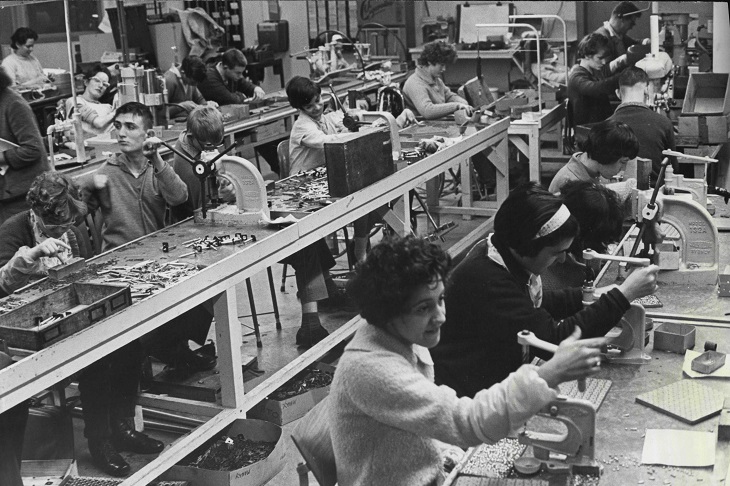Productivity is defined as a measure of the efficiency of production of goods and services, in simple terms the number of hours worked to produce an amount of product. This measure depends on a number of variables typically listed as investment, innovation, work skills, and competition.
Innovation is a magic-sounding word, not normally associated with economists’ activity. These are the same experts that appear to have no idea why Australia’s productivity has stagnated over the last 20 years.
The advent of the Labor government, with its ‘payback’, union-friendly workplace changes, will lead to increasing workplace inflexibility and productivity decline.
Despite not being an economist, I feel no less qualified to talk about this topic. Economists are reliably known for their unreliability, with their regular well-documented history of forecasting failures. It is only necessary to review their prognostications on the economy, future inflation, unemployment, interest rates, balance of payments, and stock market valuations let alone their predictions on such topics as climate change, Covid, or even next week’s weather.
As far back as 1973, Harvard economics Professor, Greg Mankiw, showed that random selection, even a blindfolded monkey throwing darts at a financial paper could result in a share portfolio that would do as well as one selected by experts. This view has been supported by the ultimate investor, Warren Buffett, the Sage of Omaha.
One aspect which has led to productivity stagnation is the lack of introduction of new technology into the workplace.
Years ago, computerisation in many jobs produced significant initial gains. Many supposed efficiencies are the result of more work done by the customer in a transaction and less by the company – think self-checkout at supermarkets and enquiries resolved by online algorithms. In this area, the much-trumpeted ‘customer satisfaction’ seems to be ignored. The use of intelligent technology is touted as the future; whether it will result in greater efficiency, or more likely fewer jobs, remains to be seen.
The increase in regulation surrounding work activity is a major impediment to efficiency and results in more parasitic workers required to administer that increased regulation. Public service numbers steadily increase and Human Resources departments assume greater, non-productive roles.
Around 2.5 million Australians are employed in the public service, 350,000 federal, 1.9 million state, and 200,000 local government employees which is a 2.3 per cent increase on 2021. Surprisingly, this huge federal number is 7 per cent less than 2012 when Julia Gillard was in charge. Some of this increase has front-line implications, with more in health, police, education, and emergency services, needed as the population expands. Conversely, studies show an increasing ratio of administrative to front-line workers.
When Tony Abbot was in charge, regular Parliamentary sessions were allocated to review and remove old legislation; this has not continued in recent years, resulting in a confusing and time-consuming over-regulated workplace. Whilst on that subject, the politicians hardly set a good example of productivity with their few sitting days for legislation, much of that taken up with petty point-scoring.
Exposure to bad news is producing an increase in stress, both at home and work, with subsequent reduced efficiency. The standard media exaggerate events to attract attention, even more so in social media. We are threatened by disease, the world coming to an end with climate change, crime rates increasing, terrorism as an existential danger… The need for counselling, for even minor events, has now become almost obligatory. American studies have shown that the average youth is now more stressed than the average psychiatric patient of the 1950s.
In addition, our failing education system, has resulted in an increasing number of new workers who have limited writing and mathematical skills while many have not acquired the concept of study or self-discipline and have no ambition coupled with an inflated idea of self-worth. In the 1950s, 12 per cent of youth considered themselves to be special, this had risen to 80 per cent. The poor education and easy access to welfare payments discourages initiative.
In combination with boring, often pointless jobs, it is no wonder that productivity is stagnating; a YouGov UK survey in 2015, revealed that 37 per cent felt they had ‘bulls**t’ jobs. The old-fashioned concept of Parkinson’s Law, promulgated in 1956 – ‘work expands to fill the time available’ – has been replaced by the recent phrase of the year for 2022, ‘quietly quitting’ – doing the bare minimum at work. The work ethic has been further undermined by the Covid pandemic, with many private workers temporarily losing their jobs whilst the public service continued to be paid for often minimal activity. With unemployment at an all-time low, the motivation to work harder is even less.
From the boss’s perspective, workers need to work harder, or longer hours for the same pay, to improve productivity. Sadly, the lost concept of jobs for life, means the loyalty in the relationship is broken in the modern era, although the concept of standard hours worked per week has changed.
In the 1850s, until early 1900s, a typical working week was 6 days consisting of 60-70 hours for 50 weeks a year. The Melbourne stonemasons, in 1855, became the first to claim an 8-hour working day.
The hours worked fell sharply in developed countries between the world wars as technology started to appear, with shorter working days and more holidays resulting in a fall from over 3,000 hours annually, to around 1,500. In the 1930s, Henry Ford instituted a 5-day week and found that accidents reduced and productivity improved. In many undeveloped countries the hours worked are unchanged, but in the developed world, the 40 hours, 5 days week has been standard for the last 70 years. The big change has been in the greater employment of women, this has often meant the equivalent of 8 days of work per couple per week, instead of the original 5. Total household income improved, often to the detriment of family life.
Much-lauded economist JM Keynes, in 1930, predicted a 15-hour week by 2030, another failed economist forecast. In 1956, US Vice President Nixon was advocating for 4-day week. In the 1960s, a US Senate Committee envisaged a 14-hour week by 2020. In 1974, during the UK miner’s strike, Edward Heath was forced to introduce a 3-day working week, to conserve electricity; a subsequent review suggested productivity had fallen by only 6 per cent. A reassessment of the working week has been underway in some countries for years, with Iceland leading the way; following a trial in 2015, 85 per cent of the workforce have made the switch to a 4-day week.
Following the Covid restrictions and work from home, studies suggested, on average, remote work was 7 per cent more productive than office work. The Victorian Greens have now suggested a trial of a work from home 4-day week, with no change in pay. The initial trial in Iceland of 36 hours 4-day week, suggested improved productivity. Over 20 other countries are now looking at similar schemes, in several European countries, UK, Canada, Japan, NZ, US; Belgium has trialled another approach with a 4 by 10 hours working week. Some businesses in Japan and Spain have reduced the pay by 20 per cent to compensate for reduced hours.
In Australia there have been 27 office-based companies in 4 working day trials, with no pay reduction, none so far plan a return to 5 days. These studies suggest similar or increased productivity, with reduced absenteeism. There may be a statistical link between reduced hours and increasing productivity, the question is one of balance.
One of the supposed advantages of the 3-day weekend is more free time, a review after two years suggested this was no longer recognised as a bonus, with something like half the workers preferring their original work schedule. Originally, the increase in leisure time was theorised to lead to boredom, idleness, immorality, or even violence. A modern German study suggests an increase in intimate relationships, socialising, relaxing, and eating. Realistically, there are many occupations where this can’t work without extra staff and resulting extra costs, for example, nursing, retail, hospitality etc, jobs often need cover for the full 7 days. A change here could also increase costs as overtime payments would become necessary.
A further step being contemplated is a 4 hours day, even a ‘4 hour working week’ as in Tim Ferris’s book, and many others of the same name. Much of this is pie-in-the-sky stuff, but many office employees are aware of time spent gossiping, messaging, and at pointless meetings. Conversely, packing 8 hours into 4 hours can increase stress for some. Many workers have become time-poor, both in and out of work, with distractions of purposeless social media activity; we already see the deleterious effect of ‘sit down money’ on the long-term unemployed. The boss would say that, rather than spend time unproductively, removal of distractions would achieve more in less time.
It seems counter-intuitive that we can achieve more with less time; how can we improve the situation before machines take over and we are all redundant? The skills of the workforce and its motivation need to improve, starting with education itself needing to become more productive. Politicians need to simplify the regulations relating to employment, with greater flexibility of time usage; something unlikely as the Union influence increases under the Labor government.
Current Labor ‘pay-back’ policies are leading to reduced workplace flexibility and pay rise demands, guaranteed to further reduce productivity, ultimately leading to job losses. An independent assessment of the public service should reduce staff numbers from ‘bulls**t’ non-jobs, as well as removing inefficiency. Similarly, big business needs to assess the value of its ever-expanding HR departments with their non-productive Woke agendas.
Rutger Bregman, in his 2014 book Utopia for realists, suggests that the solution to falling employment requirements is a basic income for all. Intelligent technology will take over many jobs, with the number in work and the hours worked declining. The question is, who will work, and how to fund the increasing number who don’t work?
The concepts of a universal wage take the debate to another future level, a level perhaps to be balanced by our falling birthrate. Renowned Science fiction writer, Isaac Asimov, prophetically wrote in 1964, ‘The ultimate factory could have two employees, a man, and a dog; the man would be there to feed dog, and the dog there to prevent man touching equipment.’
Got something to add? Join the discussion and comment below.
Get 10 issues for just $10
Subscribe to The Spectator Australia today for the next 10 magazine issues, plus full online access, for just $10.


























Comments
Don't miss out
Join the conversation with other Spectator Australia readers. Subscribe to leave a comment.
SUBSCRIBEAlready a subscriber? Log in